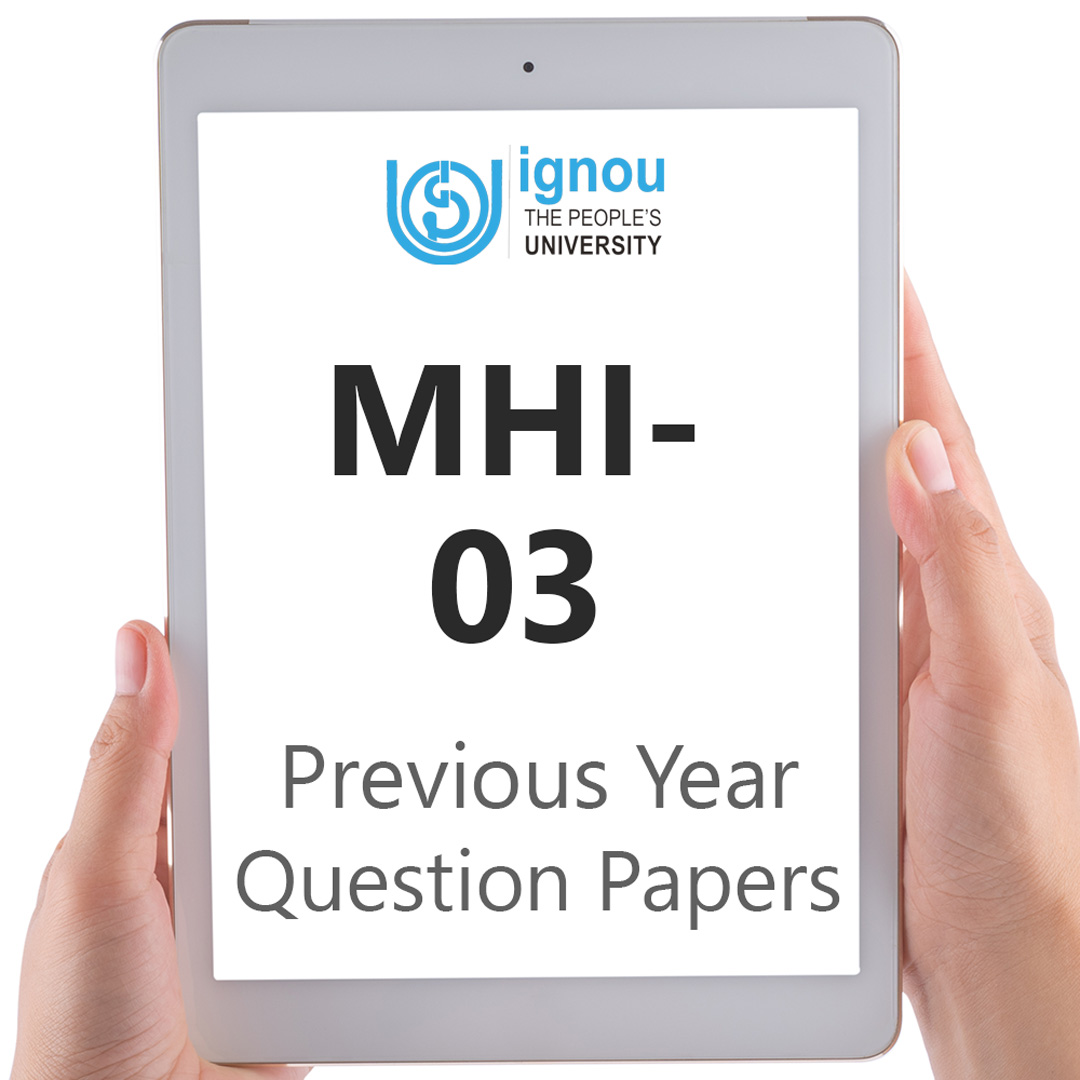If you are looking for MHI-03 IGNOU Solved Assignment solution for the subject Historiography, you have come to the right place. MHI-03 solution on this page applies to 2022-23 session students studying in MAH courses of IGNOU.
MHI-03 Solved Assignment Solution by Gyaniversity
Assignment Code: MHI-03/AST/TMA/2022-23
Course Code: MHI-03
Assignment Name: Historiography
Year: 2022-2023
Verification Status: Verified by Professor
Total Marks: 100
Note: Attempt any five questions. The assignment is divided into two Sections ‘A’ and ‘B’. You have to attempt at least two questions from each section in about 500 words each. All questions carry equal marks.
SECTION-A
Q1. What is generalisation? Discuss the role of generalisation in history-writing. 20
Ans) A generalisation is the association of unrelated or dissimilar facts over time or space. It is their rational classification and grouping. A generalisation, as defined by Marc Bloch, is "an explanatory relationship between phenomena," and it is essentially a connection or relationship between facts. It is the end result of an effort to offer a reason, cause, inspiration, and impact. More generally, historians use generalisations to make sense of their sources and try to convey their understanding of the facts to others. Generally speaking, generalisations are used to analyse and interpret events, etc.
As soon as we categorise "facts," "data," or "phenomena," compare and contrast them, or look for similarities and differences among them, and draw any inference from them, generalisation is involved. When we arrange our facts in a series and consider them all at once, we generalise. For instance, when we generalise about a leader's caste or religion, we are doing so. By establishing a link between the leader or author and their caste, we are implying that their caste played a significant role in shaping their personalities and, consequently, their political or literary work. Or even just mentioning their age. A generalisation happens more broadly when we attempt to comprehend facts, or connect data, items, events, and records of the past through concepts and communicate them to others through concepts.
Role of Generalisation
In addition to serving the purpose we've already discussed; generalisations have some additional benefits for history students:
They act as the organising principles for his or her data, solving the historian's basic issue of having a large number of disorganised facts in his notes but not knowing how to put them in some sort of order.
They enhance a historian's perception or "broaden his gaze," allowing him to take in a larger and larger portion of reality and connect increasingly intricate dots.
They allow the historian to make deductions and establish causal chains that lead to consequences or effects. In other words, they give him the ability to evaluate, comprehend, and justify his date.
Who or what, when, where how, and why are the five of the historian's trade. At most, direct facts (low level generalisations) can help us respond to who (or what), when (when), and where questions, but not how and why. The latter call for more extensive generalisations.
Generalizations specifically prompt the historian to look for fresh data and sources. A lot of times, new sources can only be understood fully through new generalisations. However, this isn't always how the process works. New generalisations typically serve as the driving force behind the search for new materials.
The historian can create new connections between well-established, well-known facts by using generalisations. A historian has always used new generalisations to understand the known facts when we say that they have been illuminated by new information.
Generalizations assist the historian in avoiding "empiricism" or "literalism," which entails accepting the sources' literal meaning or taking them at face value. He is instead encouraged to establish their importance and relevance in his storey. Consider what D. N. Naoroji said about (British) foreign rule and the appropriation of foreign funds during his lifetime. Without the use of generalisations, the inclination would be to accept his assertions at face value and quote them sequentially.
Q2. What do you understand by ‘microhistory’? Describe the historians and their works related to this tradition of history-writing. 20
Ans) Local history and oral history have an odd relationship with microhistory. Since its focus is frequently localised, it is similar to local history. Furthermore, the origins and nature of its sources are local. The micro historians also make extensive use of the local records, folklore, and oral sources that are essential to local history. The similarity, however, ends here. A distinction between "microscopic" and "microcosmic" studies was once made by M.M. Postan. Studies classified as "microcosmic" focus on a small area within a larger context, whereas "microscopic" studies are limited to topics with local significance and interest. According to this viewpoint, the microhistory is almost entirely of the "microcosmic" variety while a significant portion of local history belongs to "microscopic" studies.
Origins
In the 1970s, microhistory gained popularity in Italy. One of its founders, Giovanni Levi, claims that the approach got its start as a response to a perceived crisis in traditional historiographical theories. Another of the founding fathers of microhistory, Carlo Ginzburg, has stated that he first heard the term in 1977. Shortly after, he and Levi and Simona Cerutti started working on the Microstorie series of microhistorically works.
The term "microhistory" first appeared in 1959 with the publication of Pickett's Charge: A Microhistory of the Final Attack on Gettysburg, July 3, 1863, by American historian George R. Stewart. This book recounts the events of the last day of the Battle of Gettysburg. Fernand Braudel, an Annales historian whose use of the phrase had a negative connotation due to his obsession with the past, was another early user.
Approach
The micro historical approach's focus on small-scale research is its most distinctive feature. As a response to the generalisations made by the social sciences, which may not always hold up when tested against these smaller units, micro historians concentrate on small units in society. For instance, Ginzburg examines the life of a single Italian miller from the sixteenth century, Menocchio, in his 1976 book The Cheese and the Worms, "probably the most well-known and widely read work of microhistory." Micro historical works frequently focus on people Richard M. Tristano refers to as "little people," particularly those who are thought to be heretics.
Numerous disparaging remarks about climate scientists are made in Wolfgang Behringer's book, A Cultural History of Climate, raising questions about factual accuracy and potential bias. For instance, a controversial cartoon by Götz Weidenroth showing climate scientists making money from speaking out about the anthropogenic causes of climate change can be found on page 14 of the book's original German translation. He mentions a 3 °C rise in springtime temperatures in Europe during the early Middle Ages (between 1170 and 1310) on page 104 and contrasts this with a seemingly smaller increase in temperatures between 1891 and 1960. This seems to be cherry-picking the data to support an unsupported claim without citing any sources. Furthermore, Behringer calls for calm while asserting that climate change has historically been beneficial for humanity on page 288. He makes the unsupported assertion that we will simply adjust to a changing climate.
Q4. Who are considered to be the founders of the Annales School of historiography? Discuss their works. 20
Ans) Two friends who were studying history in Strasbourg, France, in a remote area of French academia, were very restless as a result of the history being slammed. Marc Bloch and Lucien Febvre were dissatisfied with the history they had studied and were required to teach, and they were sensitive to the perspectives that the more recent disciplines might offer. They were angry that disciplines that were so closely related to one another should be at war with one another and that each had built impenetrable walls around itself. They started publishing Annales histories economies et social in January 1929. In order to comprehend the origins of the developing crisis, the journal initially concentrated on issues of contemporary relevance; however, as time went on, it increasingly turned to mediaeval and early modern history, the fields studied by Bloch and Febvre.
The editors poignantly emphasised the importance and advantages of what would later be referred to as interdisciplinary research in the all-too-short Editorial in the journal's first issue, even while one remained firmly grounded in one's own discipline. Of course, nothing would be better than if each person, while engrossed in his or her own legitimate field of expertise and diligently cultivating their own plot of land, simultaneously made an effort to comprehend the work of their neighbour. However, the partitions are frequently so high that they obstruct our view. And yet, if these various groups interacted intellectually more frequently, what a wealth of useful ideas on method and the interpretation of facts, what cultural insights and improvements in intuition would emerge! The future of economic history and accurate knowledge of the events that will one day make up "all history" are both dependent on this.
In place of partial history, Annales was eager to create "all history," which will also be the "true history." Here, partial history of any kind was being contrasted with true history rather than false history. No part of the past or aspect of it was outside the discipline's scope; "all history" and "true history" would make up an ever-expanding domain. As a result, room was being made for taking on other disciplines' challenges and incorporating their insights.
Two paradoxical events occurred in France during the 1920s: first, the First World War had ended, and Clemenceau, the French Prime Minister, had presided over its formal conclusion at Versailles, close to Paris. Thus, symbolically speaking, it was much more France's victory over its long-time rival Germany than it was the triumph of all of Europe. The most well-known of Claude Monet's works, Les Nympheas, the Water Lilies, was created "as a bouquet of flowers presented to France after the victory," and a special museum building, L'Orangerie, was built in the middle of Paris to house them. Consequently, there was a festive vibe permeating France.
However, as the Great Depression slowly cast its shadow over the world in the latter half of the decade, there were also hints of gloom in the air. The Depression would soon overwhelm societies and economies all over the world, especially those that stood to lose the most. Among them was France.
SECTION-B
Q6. Write a note on the Marxist historiography in the West after Second World War. 20
Ans) French, British, Italian, German, and American Marxist historians started to re-evaluate the base-superstructure model that had previously been attributed to Marxism by both the Marxists and their detractors. These historians fundamentally dissociated themselves from the Marxist interpretation that gave the dominant role to the productive forces within a deterministic and teleological framework. They instead worked to create a more integrative strategy. Their archival research attested to this. In the following section, we'll talk about each of these historians and their contributions. We will discuss the main trends that these historians' works have produced in this section. Later Marxist historians found it challenging to acknowledge the dominance of productive forces and therefore placed more emphasis on the role of class conflict in determining the social structure. They also questioned the distinction between the base and the superstructure as well as the former's determining function.
In fact, they found evidence for their viewpoint in two different works by Marx and Engels. The primacy of productive forces and a teleological development were established in the abstract analysis. However, a more complex explanatory structure emerged as a result of the analysis of the actual events, with the struggle between classes acting as the main driver. Many Marxist historians adopted this position and claimed that the main force driving change was class conflict. For instance, F.W. Wal bank claimed that there was no evolution of productive forces from Greek to Roman times in his analysis of the decline of the Roman Empire in his book The Decline of Roman Empire in the West.
The basis for these production relations was slavery, which discouraged both slaves and slaveowners from seeking out any sort of technological advancements. It resulted in a situation where a top-heavy political apparatus failed to survive because there was no corresponding growth of productive forces. Similar to this, Robert Brenner and Eugene Genovese identify the dominant relations of production (feudal relations in Europe and slavery in nineteenth-century America, respectively) as the cause of social and political decline rather than the conflicts between growing productive forces and static relations of production.
However, these historians generally maintain that any society's crisis and change were primarily brought on by its internal dynamics rather than any outside influences. Due to internal conflicts rather than a resurgence in trade, feudalism thus declined. Similar to how internal weaknesses, rather than barbarian invasions, caused the Roman Empire to fall.
Thus, Marxist historians have a tendency to group various societies according to their typical production relations rather than according to their productive forces when writing in epochal terms. Additionally, there are disputes regarding the existence of different production methods. For instance, the majority of Marxist historians do not agree with the idea of the "Asiatic" mode of production. Similar findings were made regarding the slave mode of production, which did not hold true for many societies, including India. In fact, some historians contend that even in ancient Greek and Roman societies, slaves did not constitute the majority of producers and that the practise of chattel slavery was confined to specific regions and times. The ancient world cannot, therefore, be categorically characterised as a slave mode of production.
Q7. Compare the colonial historiography in India with the nationalist historiography. 20
Ans) A nationalist approach to Indian history can be defined as one that tends to strengthen nationalist sentiment and bring people together in the face of class, caste, or religious divisions. As was already mentioned, sometimes this may occur regardless of the author's intentions.
Indian historians initially adopted the colonial historiography's approach to history in the 19th century, viewing it as a fact-based science that placed a strong emphasis on political history, including the history of ruling dynasties. In writing India's history starting in the late 18th and early 19th centuries, colonial authors and historians effectively created an empire spanning all of India. Parallel to this, colonial historians throughout much of Indian history stressed the division of Indians based on region and religion, following the same political strategy as the colonial rulers, who practised divide and rule.
Nationalist historians also emphasised a ruler's religion, caste, or linguistic affiliation when writing about the history of either India as a whole or of individual rulers who oversaw various regions of India. But as the colonial historical narrative shifted to a justification for colonialism rather than a justification of India's political and social development, Indian historians began to take a nationalist stance. Day by day, colonial historians began to stereotype Indians more and more.
James Mill's work on ancient India and Elliot and Dawson's work on mediaeval India were fundamental works in this regard. In an effort to combat the colonial stereotypes that were constantly being thrown at them, Indian nationalist historians set out to create counter-stereotypes. Nationalist historiography emerged as a response to and in confrontation with colonial historiography, as well as an effort to develop national self-respect in the face of colonial denigration of Indian people and their historical record, just as the Indian nationalist movement did to oppose colonialism. Both sides used historical references in their daily speech and writing. Even when discussing the most complex or enigmatic historical topics, Indians frequently based their explanations on earlier European interpretations.
Many colonial historians also believed that autocratic or despotic rule over India, like other countries in the East, was in India's nature. Because of this, British rule in India had to be autocratic and was. The theory of Oriental Despotism became the popular name for this viewpoint. Furthermore, these authors contended that India did not subscribe to the idea that any ruler's goal should be the welfare of those they rule. In actuality, India's traditional political systems were "monstrously cruel" by their very nature. In contrast, the British were fair and benevolent, even though they were autocratic, and they worked for the welfare of the populace. British rule was benevolent but autocratic, in contrast to the cruel Oriental Despotism of the past.
The colonial writers also believed that Indians had always been divided because, in contrast to Europeans, they had never felt a sense of nationality and, as a result, of national unity. They claimed that Indians had no democratic tradition. While ancient Greece and Rome had left behind a democratic legacy for Europeans to enjoy, despotism was the legacy of all people from the Orient or East, including Indians.





